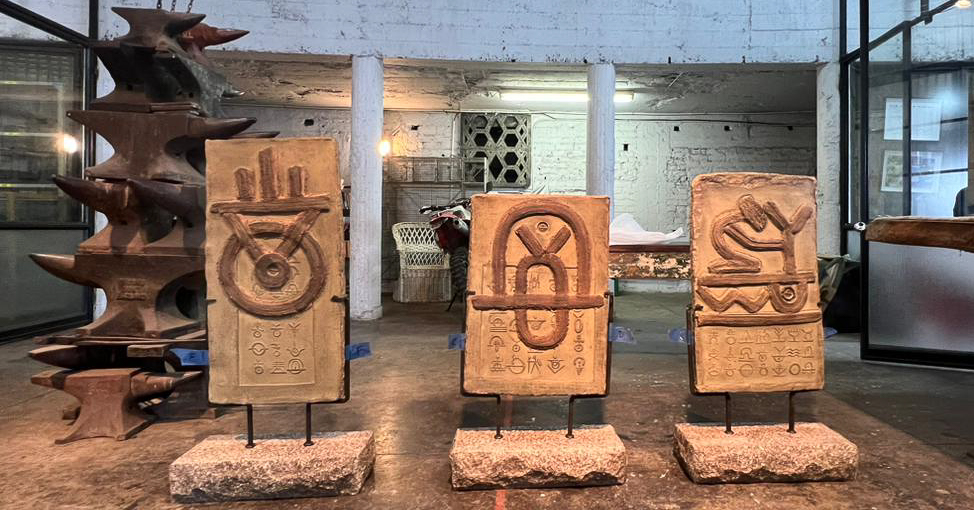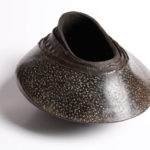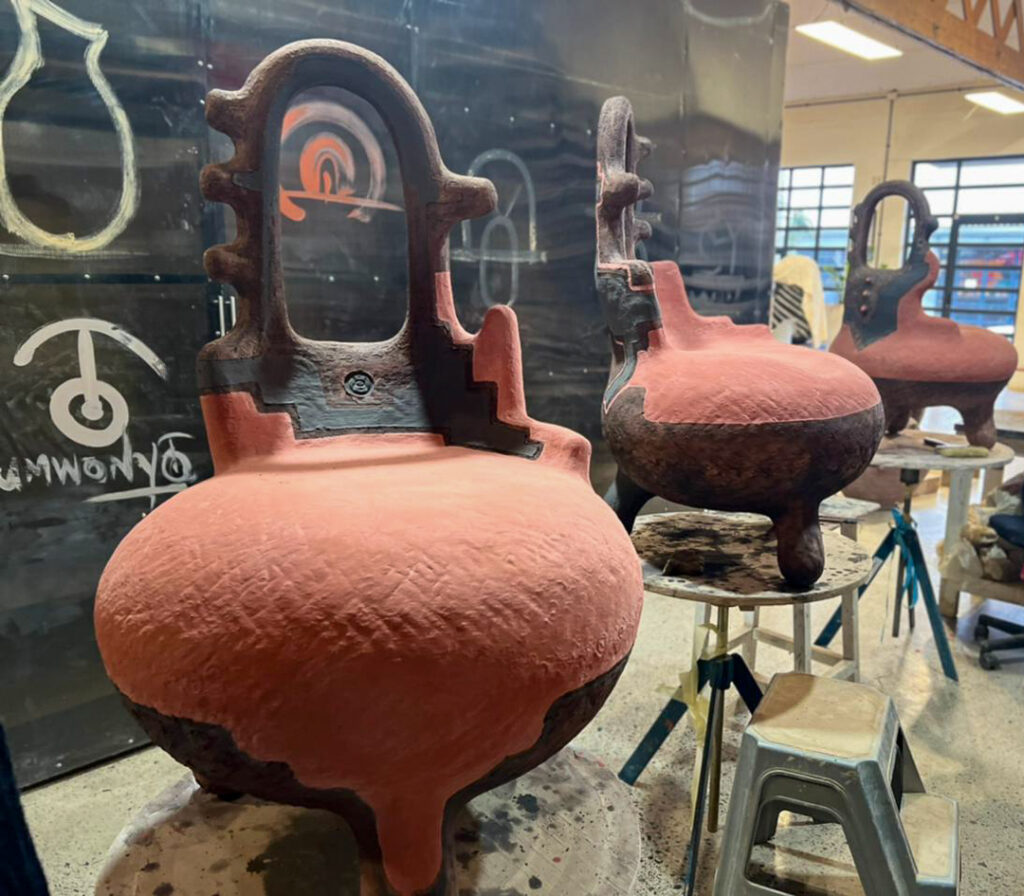
Andile Dyalvane, Uyezelo tablets, 2022, Glazed earthenware, rusticated granite, blackened mild steel
Andile Dyalvane’s ceremonial ceramic works embody traditional knowledge about nature transmitted by ancestors.
Andile Dyalvane creates works that sustain a spiritual connection to his Xhosa roots. The ceramic chairs are used in ceremonies that honour the ancestors of his OoJola clan. They are usually arranged in a circle around a fire hearth with herbal offerings. The works are inscribed with Xhosa pictograms, such as entshonalanga (“sunset”), igubu (“drum”), umalusi (“herdsman”) and izilo (“totem animals”). They invoke spirits to guide us through life. Andile Dyalvane’s practice is guided by a deep spiritual connection to his Xhosa ancestors who communicate through various symbology and dreams. “Uyalezo” is the isiXhosa term for this form of spiritual message.
Since 2016, Dyalvane has been developing his own system of pictograms to denote important concepts in Xhosa life – such as “entshonalanga” (sunset), “igubu” (drum), “umalusi” (herdsman) and “izilo” (totem animals). He says: “Symbols are visual tools harnessed to more effectively impart meanings within messages – codes, if you will – that aid stories.” These glyphs animate his work, whether embodied in their sculpted forms or stamped and painted into their surface.
In the series of clay tablets produced for the Tel Aviv Biennale of Crafts & Design, Dyalvane records information passed on through uyalezo in a way that is embedded with supernatural, cosmological, and ecological potency. This is a form of both remembrance and note-keeping as would have been traditionally practiced in the storytelling medium of rock painting by Khoisan shaman-artists in Southern Africa.
The intent for survival has guided the artist’s technique, creating robust and heavy-weighted solid ceramic tablets grounded in their reference to ancient relics. These sacred objects will surpass our lifetime, thus withstanding the limitations of time and place. Being earthen, or ‘living’, clay is limited by its perceived fragility, however, through the process of being fired these totems harden to contain uyalezo and iSihlwele (Ancestral Spirit).
Similarly, the tablets act as a manifesto, outlining iSilo seKhaya (Domestic Animal) an ancestral animal totem assigned to every family group within the Xhosa people. Usapho (Family) refers to how Uyalezo guides the collective community’s conversations, activities and functionality. For instance, uMlimi (Farmer) is guided by uCanzibe (Canopus), the brightest star visible in the Southern Hemisphere, which signals the time for harvesting. According to the Xhosa calendar, Canopus is also the name given to the month of May. uMlimi (Farmer) is led by Ixesha (Time), patiently waiting between harvest, drought and rainy seasons, and observing the climate and the performance of nature. However, the farmer, like the rest of the community, is also subject to the messaging from iSihlwele (Ancestral Spirit).
In his latest series, Dyalvane harnesses metaphysical questions of being and existence, asking: What does ‘family’ mean to the stars? What kinds of activities happen during the stars’ highest point in the sky?
The voluptuous, rounded bases of the ceramic seats are low, sitting close to the earth – the ground revered as an ancient portal for ancestral communion. Their forms are curved and spherical, echoing the traditional “rondavel” structures and kraal enclosures in which livestock are kept. Circular geometry is believed to facilitate a free exchange of energy in Xhosa spiritual practices (as it is in many other belief systems), in keeping with the organic shapes found in nature.
Language, symbols, ancient writing systems and calligraphy are all important motifs within Dyalvane’s quest to preserve and promote African heritage, practiced by pairing new traditions with ancient technology. The bas-relief scripture projecting from each tablet’s surface references the artist’s own calligraphic notebooks, where textured brush strokes echo the value of each letter or symbol he inscribes.
Andile Dyalvane explains how he came by the knowledge embodied in these works.
The knowledge about the symbolism comes through visions, loosely translated as dreams. We call it iThongo. So this is how the ancestors communicate, to me and to those of us who have a gift of seeing either from the past or the future, or the present as healers.
Once the vision comes through, it may be an ancient gathering, or lost practice, I paint that vision with three or four brushstrokes, which represent the symbol. Then those brushstrokes then carry the meaning and the message of that vision. If I do not know how to dissect that vision or that messaging, then I consult the elders in my community or in my family and tell them about it. Or I’ll consult a healer and then the healer will be able to dissect and state what exactly it is. It may be an ancient practice and ancient knowledge that has been lost that is coming through now.
Then comes a narrative about each and every symbol and I write a document. It’s not a knowledge that is documented in institutions. This is an indigenous knowledge that has been passed on from generation orally. This is very important because we have suffered as a people through most western institutions not wanting to acknowledge the traditional or indigenous knowledge that has been passed down orally from the elders from generation and generation. So this is my duty and my purpose and my gift as a conduit of the sort of knowledge that comes through with this symbolism.
UYalezo – New Traditions will be exhibited at the Tel Aviv Biennale of Craft & Design, 30 March – 30 November, 2023
Andile Dyalvane is represented by Southern Guild




